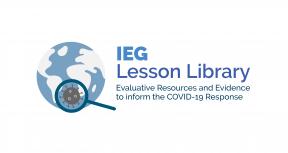The global economic crisis of 2008-2009 led to a sharp reduction of growth worldwide with an increase in millions of poor persons. The World Bank Group responded with an unprecedented expansion of support that included the majority of countries suffering high levels of stress. The bulk of crisis support focused on moderately affected countries. Due to its unprecedented support, largely through traditional rather than crisis specific instruments, the World Bank now has constrained headroom for future crisis response should it become necessary.
This second phase evaluation of World Bank Group’s response to the economic crisis reaffirms some of the findings of the first phase, particularly sharply increased financing at the World Bank, as well as greater processing efficiency and disbursement speed; the positive role in crisis response of well-established country dialogue and country knowledge; and the value, for crisis response, of the Bank’s comfortable financial position at the start of the crisis. At the International Finance Corporation (IFC), the Phase II response reaffirms the broadly constant levels of investment and creative crisis initiatives that were sometimes difficult to implement rapidly. The study also confirms that the Multilateral Investment and Guarantees Agency (MIGA) provided countercyclical support to key financial institutions in Eastern Europe during this crisis.
New themes in the Phase II evaluation include the distribution of Bank Group support across its client countries measured in multiple dimensions; the appropriateness of its instruments; and the quality of its intervention in fiscal, financial and social protection sectors. The evaluation also reviews the choice of instruments used, in the broader context of other international financial institutions (IFIs) and multilateral development banks (MDBs).
The report finds that the World Bank provided lending to the majority of countries suffering high levels of stress and supported relevant financial sector and fiscal management policies in these countries. The bulk of crisis support focused on countries that turned out to be moderately affected. Crisis operations had in many cases limited short-term crisis-response policy content and in some cases fell short of solid medium-term engagement. Although the Bank provided substantial support in social protection to a number of countries, it was hampered by limited country capacity to target those who were made poor by the crisis, and, as a result, the bulk of support went to the chronically poor.
The evaluation finds that the International Bank for Reconstruction and Development (IBRD) now has considerably more limited capacity to accommodate further crisis response, if this becomes necessary. This is partly a result of the magnitude of IBRD’s lending response, the predominant use of traditional instruments, a decline in lending rates to middle income countries just before the crisis, and a decline in global interest rates, IFC’s crisis response reflected a strategic choice to protect its portfolio. It also overestimated the deterioration in portfolio quality. MIGA could have used the crisis situation to increase new crisis guarantees in line with other political risk insurers.
Findings
World Bank
- The World Bank’s response to the crisis shared similarities with other IFIs and MDBs, in terms of the sharp acceleration of support provided mostly to middle income countries and largely through quick-disbursing instruments, there were also differences in the pattern of lending distribution. The Bank’s lending to its client countries was not correlated with the differential stress experienced by these countries, while the lending of other IFIs and MDBs was. This does not imply that Bank support was necessarily unjustified. Other factors in crisis response also matter, including, giving signals of support to calm markets and coordinating responses with partner IFIs. Bank loans were generally lower in cost than other IFIs and MDBs. At the same time, the Bank made less use of crisis specific instruments with shorter maturities and premia on interest rates, which could have helped it to preserve its headroom.
- The magnitude of the lending response, the decline in global interest rates, the use of traditional instruments and their low rates has left the World Bank with limited headroom to accommodate further crisis response, should it be needed.
- Financial sector lending escalated during the crisis from $25 billion to $53 billion. However, most of the Bank’s clients were not deeply affected in terms of financial system distress, reflecting, in many cases, positive effects of previous Bank engagement. In deeply stressed countries, its lending contained relevant policy content and contributed to stabilization, even if only a small part of total donor funds. Most financial sector lending went to countries suffering a moderate degree of financial stress, and its crisis related operations, based on areas where swift preparation was possible, were not very different in content from non-crisis lending.
- Support for fiscal management was extended to 67 Development Policy Operations in 48 countries. About 54 percent of this support went to countries experiencing moderate levels of stress. Some operations had relevant crisis support content while in others the content was not related to the crisis. Support for maintaining pro-poor expenditures for health and education was included in around half the operations.
- Support to social protection was hampered by limited country capacity, including lack of necessary knowledge, data and preexisting social mechanisms to target those who were made poor by the crisis. Much of the Bank’s crisis support for social protection focused on programs such as social safety nets, which are designed to protect the chronically poor.
IFC
- IFC did not increase its investment to respond to the crisis protecting its portfolio from potential crisis impact. It took significant steps to protect its existing portfolio. The study finds that IFC’s stress tests overestimated potential adverse effects of the crisis on its portfolio quality.
- An important part of IFC’s crisis response took the form of global initiatives, most of which were newly established for the crisis. Among the most successful were the Global Trade Finance Program (GTFP), which raised $3 billion in late 2008 to extend guarantees to international banks to cover trade finance risks, and the Global Trade Liquidity Program, which pulled together $4 billion as of early 2010 to fund trade finance in individual banks. The GTFP was however not a new initiative, but along with new initiatives, such as the Microfinance Enhancement Fund and the Bank Recapitalization Fund, though relevant in terms of design, took time to establish.
MIGA
- MIGA’s countercyclical interventions were important for key financial institutions in Eastern Europe.
- Compared to other similar public and private insurers, MIGA’s activities declined in relative terms over the crisis period. This was largely due to MIGA’s assessment of potential risks and restrictions in its Convention and operational regulations.
Lessons
- Continuing global uncertainties and slow recovery from the current crisis show the need to improve future crisis preparedness. The World Bank Group would benefit from a roadmap that includes a systemic analysis of stress factors and a decision-making process for blending country-level responses within a global strategy that focuses on applying scarce resources where they are most effective.
- The World Bank would benefit from a review of its current instruments for crisis support to find ways to support severely affected countries as well as less affected countries according to their needs, while better preserving its own headroom and recognizing constraints on medium- term reform engagement during crises.
- In recognition of the value of prior country knowledge and engagement, the Bank Group could consider formalizing commitments to maintain strong knowledge in countries for effective crisis interventions in the future.
- The World Bank could benefit from a system-wide approach to social protection and risk management, developing “nuts and bolts” of social protection programs and strengthening country systems for greater future crisis preparedness.
- IFC could usefully review its stress test methodology to optimize its investment strategy to effectively respond to crises and institutionalize successful crisis arrangements, enabling the institution to be rapidly activated in times of need.
- MIGA could accelerate the expansion and diversification of its business plan.




